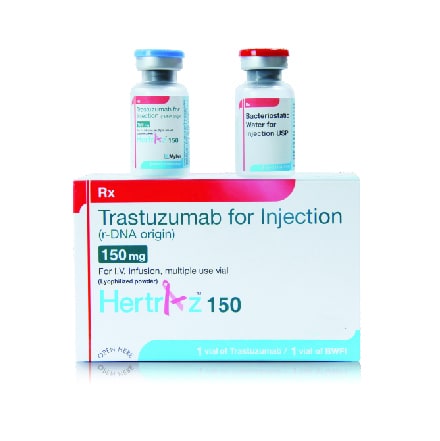Product Introduction:
Hertraz is an anti-HER2 monoclonal antibody, developed by Mylan (Biocon Biologics), used in the treatment of HER2-overexpressing cancers. It is available as lyophilized powder for reconstitution in strengths of 150 mg (single-use vial) and 440 mg (multi-dose vial with bacteriostatic water for injection).
Uses (Indications):
Trastuzumab is indicated for the treatment of HER2-overexpressing cancers, including:
-
HER2-positive early breast cancer – as adjuvant therapy after surgery and chemotherapy
-
HER2-positive metastatic breast cancer – alone or in combination with chemotherapy agents (e.g., paclitaxel, docetaxel)
-
Neoadjuvant setting – prior to surgery for locally advanced HER2+ breast cancer
-
HER2-positive gastric or gastroesophageal junction adenocarcinoma – in combination with cisplatin and fluoropyrimidines
-
Maintenance therapy – post-chemotherapy for metastatic HER2-positive cases
-
Investigational in HER2-overexpressing solid tumors outside breast and gastric cancers
Storage Instructions:
-
Store the vial between 2°C to 8°C in a refrigerator
-
Do not freeze the product, either before or after reconstitution
-
Protect from direct light and moisture
-
The reconstituted 150 mg vial must be used immediately
-
The reconstituted 440 mg vial (with bacteriostatic water) can be stored for up to 28 days at 2°C to 8°C
-
Inspect visually for particulate matter or discoloration before administration
How It Works (Mechanism of Action):
Trastuzumab is a monoclonal antibody that selectively binds to the HER2 (human epidermal growth factor receptor 2) protein on the surface of cancer cells.
-
HER2 is a transmembrane receptor overexpressed in 15–30% of breast cancers
-
Trastuzumab blocks ligand-independent HER2 signaling, leading to inhibition of cell proliferation
-
It also mediates antibody-dependent cellular cytotoxicity (ADCC), recruiting immune cells to destroy HER2-expressing tumor cells
-
This dual mechanism slows tumor growth, causes apoptosis, and enhances the efficacy of other anticancer agents
Side Effects:
Common Side Effects:
-
Fever, chills, and flu-like symptoms (especially during the first infusion)
-
Fatigue
-
Nausea and vomiting
-
Headache
-
Diarrhea
-
Rash and skin irritation
Severe Side Effects:
-
Cardiotoxicity – decreased left ventricular ejection fraction (LVEF), heart failure
-
Severe infusion-related reactions – dyspnea, hypotension, bronchospasm, anaphylaxis
-
Pulmonary toxicity – interstitial pneumonitis, acute respiratory distress
-
Hematologic toxicity – neutropenia, leukopenia (especially in combination regimens)
-
Liver dysfunction – elevated liver enzymes
-
Hypersensitivity reactions – including rare anaphylaxis
Dosage (Typical Recommended Dose):
For Breast Cancer:
-
Initial loading dose: 8 mg/kg IV infusion over 90 minutes
-
Maintenance dose: 6 mg/kg IV infusion over 30–90 minutes every 3 weeks
For Gastric Cancer:
-
Initial loading dose: 8 mg/kg IV infusion
-
Maintenance dose: 6 mg/kg every 3 weeks until disease progression or unacceptable toxicity
Note: Dosage must be calculated based on body weight, and cardiac function must be monitored routinely.
Method of Administration:
-
Reconstitute lyophilized powder using sterile water for injection (150 mg) or bacteriostatic water (440 mg)
-
Dilute the required dose in 250 mL of 0.9% normal saline
-
Administer intravenously via infusion; not as IV push or bolus
-
First infusion over 90 minutes, subsequent infusions over 30–60 minutes
-
Monitor patient closely during and after infusion for any infusion-related reactions
Precautions:
-
Perform baseline echocardiogram or MUGA scan to assess cardiac function
-
Do not initiate or continue therapy if LVEF drops significantly
-
Avoid in pregnancy and breastfeeding – may cause fetal harm (Pregnancy Category D)
-
Use effective contraception during and for at least 7 months after the last dose
-
Monitor for signs of pulmonary toxicity – dyspnea, cough, or new lung infiltrates
-
Caution in patients with pre-existing cardiac conditions, asthma, or elderly patients
Drug Interactions:
-
Anthracyclines (e.g., Doxorubicin) – increased risk of cardiotoxicity, avoid concurrent use
-
Cyclophosphamide, Taxanes (Docetaxel, Paclitaxel) – common combination agents, monitor for cumulative toxicities
-
Live vaccines – should be avoided due to immunosuppressive effects of cancer therapy
-
Other monoclonal antibodies or biologics – caution due to potential overlapping toxicities
-
Trastuzumab has minimal CYP450 interaction as it is a biologic agent
Allergies (Warnings for Allergic Reactions):
-
Hypersensitivity to Trastuzumab, murine proteins, or any excipients is a contraindication
-
Symptoms may include rash, fever, hypotension, bronchospasm, or angioedema
-
In case of hypersensitivity, infusion must be stopped immediately, and emergency treatment initiated
-
Pre-medication with antipyretics or antihistamines may be used in patients with a prior mild reaction
Overdose Information:
-
No specific antidote exists; overdose should be managed supportively
-
Patients may experience severe infusion reactions, cardiac dysfunction, or pulmonary issues
-
Monitor vital signs, cardiac function, and provide intensive medical care if needed
-
Hospitalization may be required for observation and symptomatic treatment
Missed Dose Instructions:
-
If a dose is missed, administer it as soon as possible
-
Do not double the next dose
-
If the interval between doses exceeds 1 week, repeat the loading dose (8 mg/kg)
-
Always follow the advice of the treating oncologist when reinitiating therapy
Additional Notes:
-
Hertraz is a biosimilar approved in India and many international markets, providing a cost-effective alternative to the original Herceptin
-
It must be used only in HER2-positive tumors, confirmed by IHC or FISH testing
-
Cardiac function monitoring is a critical component of trastuzumab therapy
-
Patient education on infusion symptoms, fertility precautions, and follow-up scans is essential
-
Hertraz is widely used in national cancer programs and is included in many oncology treatment guidelines



